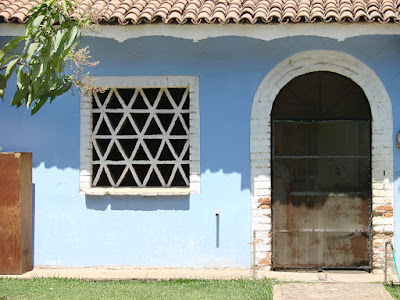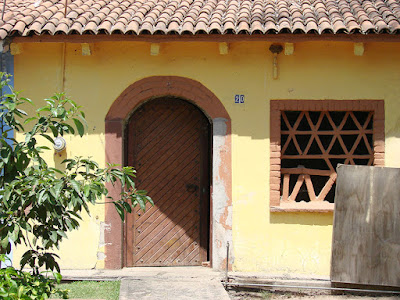

Photo sets can be found anywhere, these houses were next door to each other.
A photo set is when you match aspects of one photograph with that of another photograph or photographs.
I’m sure you’ve been in hotels or restaurants that have a series of images—all related—on their walls.
And…you probably also know that if you can sell one image that’s popular, you can sell many that are similar to it.
Another useful element of creating photo sets is that matched photo sets on a Web page make it more readable when the photos are accompanied by text.
There are many ways you can match your photographs with each other:
1. A butterfly, person, or any other subject shown from different angles in the same background.
2. Photos with the same hues and tones, perhaps taken in the same city at a certain time of year like Paris in the winter and even taken using the same camera settings.
3. Things things that are related to each other in some way such as a series of machines, radios, signs (of course!) and vintage autos.
Check out the photos below, how are they alike. Please comment on them by clicking on the comments section below.
Set 1
Set 2
Set 3
Shooting while Moving Photo Sets
A quick way to get a fast shutter speed is in within the auto modes of your camera. The picture of the running man (sports mode) will achieve remarkable results while you are moving in a plane, train or automobile.
Don’t recommend that you shoot while you’re driving, but while you’re a passenger on a car, bus or plane, you can get some incredible photo sets using the sports mode auto setting. And if there’s no glare on the window you can keep the window closed. If you do the glass acts somewhat as a polarizing filter (a filter that blocks out UV light and haze, making for a clearer pic).
Photoshop Sets
If you don’t have transparencies or photo filters, you can use the photo filters in Photoshop for a similar effect (Image>Adjustments>Photo Filter…)
Filters in Photoshop work differently than those that you attach to your camera’s lens. With so many choices, menu bars, values, colors, and patterns to choose from, you might wonder why you even need a camera at all! As a photographer, though, I’m sure you want to work with your own images because in Photoshop, starting with your own exposures can let you create many effects from the same shot.
When you apply some of the special effects of image processing programs, sometimes your image will appear to have lost resolution. Truth be told, some effects look no better than unwanted noise in your digital image. But then again, you might just craft an artistic view that is creative and compelling. Be very selective when using any filter in any image processing program because some filters work better than others. Some are meant to give your picture but a slight edge over the original. Many images sell with just this technique: that is, a simple image surrounded by a beautiful solid colored background.
Photoshop has literally hundreds of effects (Filter>…) that you can use to finesse an image or recreate to another image for a photo set. The choices available range from subtle to dramatic to downright bizarre and surreal. How far you want to take your art photography from its original state is a matter of your taste and the outcome you desire.
One of the most famous photographs of a child, Candy Store, Amsterdam Avenue New York (1954) was shot by William Klein (It can be viewed here.) The photograph shows a boy stooped down in front of candy store (both foreground and background blurred by the camera’s lens). Klein used blur to make images that some referred to as photography that didn’t meet up to standards of quality. Despite this, his work with blur became especially notable, and there’s a similar kind of blur that you can implement in your work using Photoshop.
I’m sure you’ve been in hotels or restaurants that have a series of images—all related—on their walls.
And…you probably also know that if you can sell one image that’s popular, you can sell many that are similar to it.
Another useful element of creating photo sets is that matched photo sets on a Web page make it more readable when the photos are accompanied by text.
There are many ways you can match your photographs with each other:
1. A butterfly, person, or any other subject shown from different angles in the same background.
2. Photos with the same hues and tones, perhaps taken in the same city at a certain time of year like Paris in the winter and even taken using the same camera settings.
3. Things things that are related to each other in some way such as a series of machines, radios, signs (of course!) and vintage autos.
Check out the photos below, how are they alike. Please comment on them by clicking on the comments section below.
Set 1
Set 2
Set 3
Shooting while Moving Photo Sets
A quick way to get a fast shutter speed is in within the auto modes of your camera. The picture of the running man (sports mode) will achieve remarkable results while you are moving in a plane, train or automobile.
Don’t recommend that you shoot while you’re driving, but while you’re a passenger on a car, bus or plane, you can get some incredible photo sets using the sports mode auto setting. And if there’s no glare on the window you can keep the window closed. If you do the glass acts somewhat as a polarizing filter (a filter that blocks out UV light and haze, making for a clearer pic).
Photoshop Sets
If you don’t have transparencies or photo filters, you can use the photo filters in Photoshop for a similar effect (Image>Adjustments>Photo Filter…)
Filters in Photoshop work differently than those that you attach to your camera’s lens. With so many choices, menu bars, values, colors, and patterns to choose from, you might wonder why you even need a camera at all! As a photographer, though, I’m sure you want to work with your own images because in Photoshop, starting with your own exposures can let you create many effects from the same shot.
When you apply some of the special effects of image processing programs, sometimes your image will appear to have lost resolution. Truth be told, some effects look no better than unwanted noise in your digital image. But then again, you might just craft an artistic view that is creative and compelling. Be very selective when using any filter in any image processing program because some filters work better than others. Some are meant to give your picture but a slight edge over the original. Many images sell with just this technique: that is, a simple image surrounded by a beautiful solid colored background.
Photoshop has literally hundreds of effects (Filter>…) that you can use to finesse an image or recreate to another image for a photo set. The choices available range from subtle to dramatic to downright bizarre and surreal. How far you want to take your art photography from its original state is a matter of your taste and the outcome you desire.
One of the most famous photographs of a child, Candy Store, Amsterdam Avenue New York (1954) was shot by William Klein (It can be viewed here.) The photograph shows a boy stooped down in front of candy store (both foreground and background blurred by the camera’s lens). Klein used blur to make images that some referred to as photography that didn’t meet up to standards of quality. Despite this, his work with blur became especially notable, and there’s a similar kind of blur that you can implement in your work using Photoshop.


 2 ... 2 ...
2 ... 2 ...
0 comments:
Post a Comment